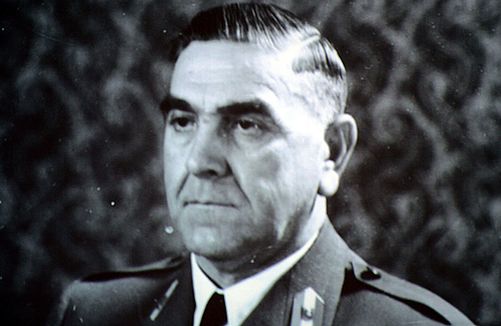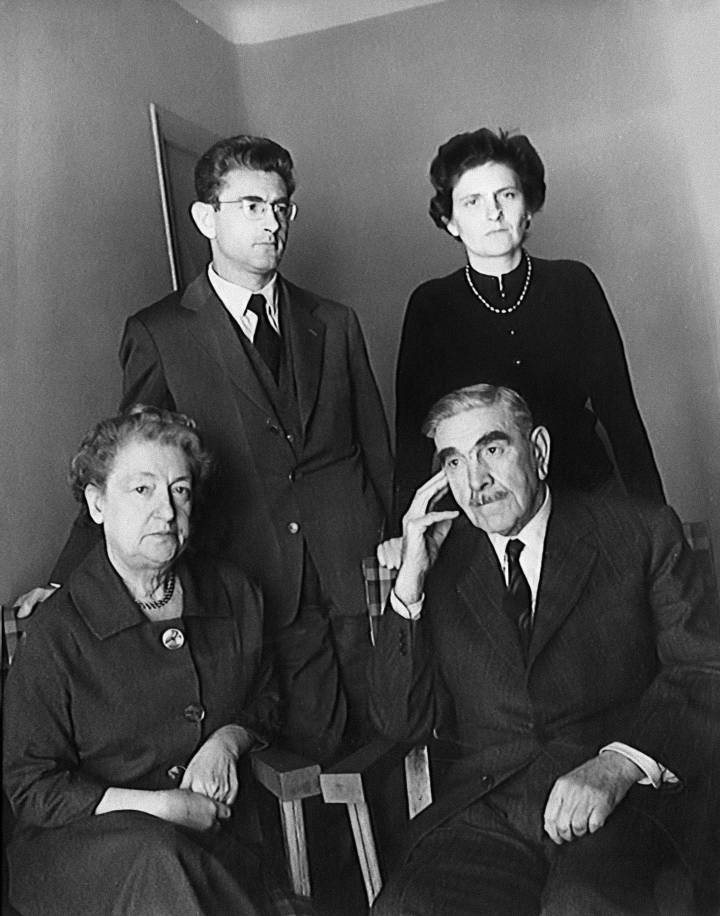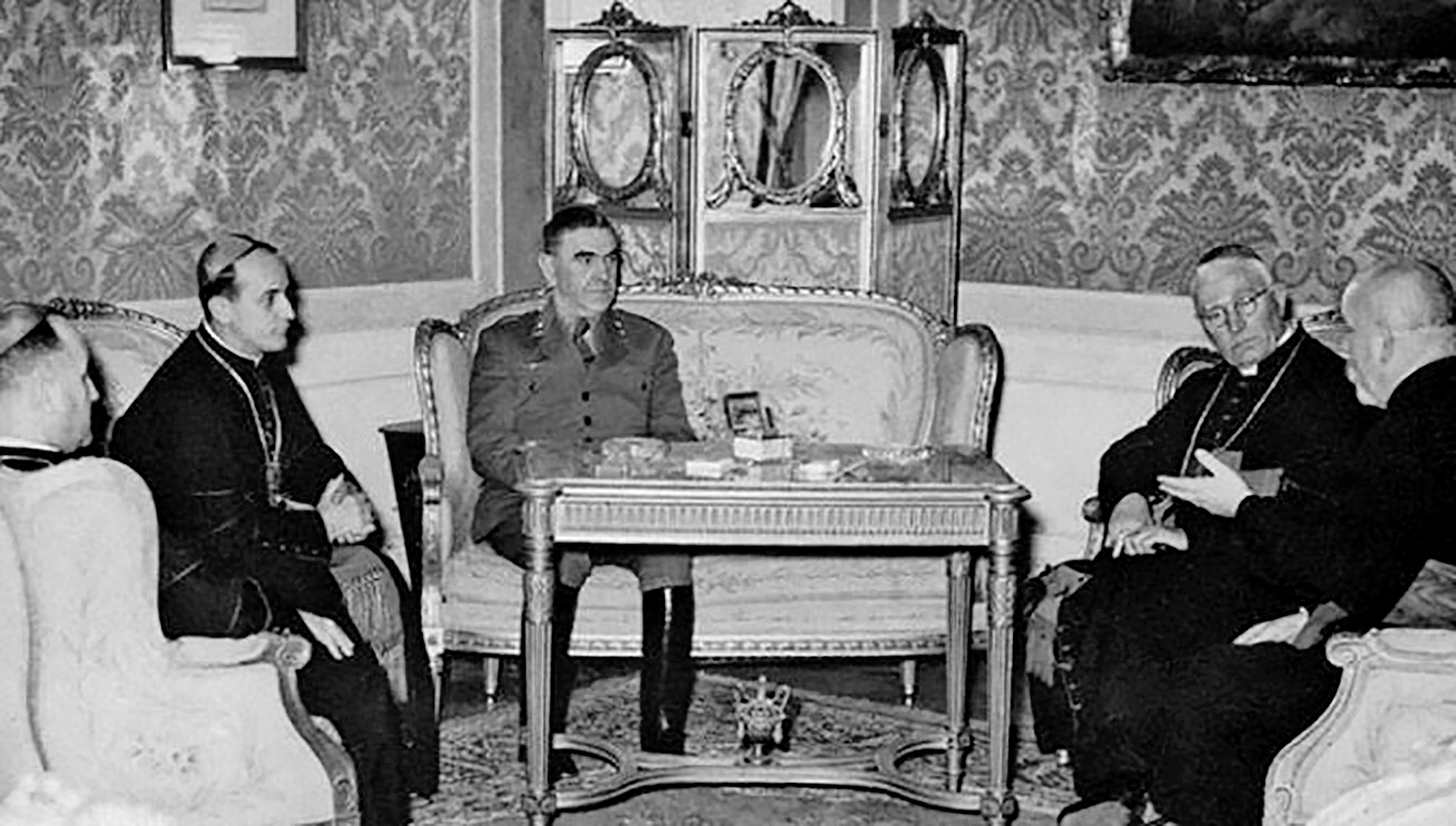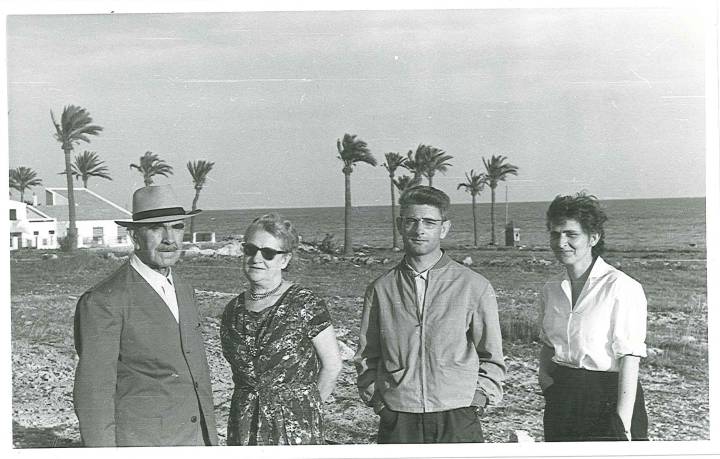Period:
Second World War
Region:
ISC
The Croatian criminal and fascistic leader Ante Pavelić
Ante Pavelić (1889-1959) was a Croatian clerical-fascist politician, founder, and leader of the extreme right-wing Ustasha movement.
After the occupation of Yugoslavia in spring 1941, he was appointed head of the Quisling Independent State of Croatia (NDH) and led it using the title of poglavnik (leader).

Ante Pavelić was a lawyer by profession and a politician from the ranks of the Croatian Party of Rights during the Kingdom of Yugoslavia, known for his chauvinistic beliefs about independent Croatia.
The genocidal regime led by Pavelić was responsible for mass persecutions of Serbs, Jews, and Roma living in the NDH, including monstrous killings of millions of Serbs, tens of thousands of Jews and Roma, and rarely the persecution of anti-fascist Croats.
The racial policies of the NDH had significantly contributed to the rapid loss of control over the occupied territory, where the people went to the woods in large numbers making guerilla units and even forcing German authorities to try to restrain Pavelić and his genocidal campaign.
BIOGRAPHY
He was born on 14 July 1889 in the Herzegovinian village Bradina on Ivan Mountain, then part of the Austro-Hungarian condominium of Bosnia and Herzegovina.
His parents: father Mile (a railway worker) and mother Marija, moved from the Lika village of Krivi Put in the central part of the Velebit plateau to work on the construction of the Sarajevo-Jadran railway.
Pavelić attended primary school in various places in Bosnia and Herzegovina, depending on where his father worked. He attended high school in Travnik, Senj, Karlovac, Zagreb where he graduated in 1910.
During high school, he joined the Croatian Party of Rights (HSP). After graduation, he enrolled at the Faculty of Law in Zagreb.
He graduated law in 1914, and in 1915 received the honorary title of doctor iuris.

Ante Pavelić with his family
From 1915 to 1918 he worked as a certified notary in the law office of A. Horvat, president of HSP. Having finished his internship (1918), he started working as an independent lawyer.
In that period he married Mara Lovrenčević, with whom he had three children: son Velimir and daughters Mirjana and Višnja.
Political rise
He was an extremist even in his early youth and became a member of the organization better known as “Frankovci”.
In 1919 he served as interim secretary of the Pure Party of Rights. As explained by the British historian A.P.J. Taylor, when some people in the Croatian Party of Rights refused to enter into a conflict with Serbs, which was the alpha and omega of the party’s political activity, the party majority formed the Pure Party of Rights “cleansed of any traces of realism” - according to Taylor.
Two years later, Pavelić was arrested together with several other members of the party, then released, and tried to defend the arrested party members in court, which he failed to do.
Pavelić’s quarrelsome nature became more and more visible in the years immediately after World War I when he became involved in the conflicts between the Centrist Party and Radić’s Croatian Peasant Party. He was the only member of his party in the National Assembly of the Kingdom of Serbs, Croats, and Slovenes, and was rarely present at the session but when he was, ‘he was silent and inactive, sitting in his chair and only occasionally got involved in long harangue - protests against the measures he did not approve of’.

Croatian flowers: Islamised Serbs
In the early 1920s, Pavelić began to establish contacts with Croatian emigration in Vienna and Budapest who hid there after World War I, and later with the terrorist organization VMRO from southern Serbia. In 1927 he became the advisor to the defense of the terrorists during the Skopje trial.
In the same year, 1927, he was elected the provincial representative of Zagreb, and in June that year, he represented Zagreb county at the European Congress of Cities in Paris.
On his return to Rome, he handed over a program to the envoy of the Italian government, Davanzati, on behalf of the HSP, in which they offered Italy cooperation to overthrow the Kingdom of SCS. Accordingly, he expected Italian assistance in establishing and protecting the Croatian State and stated the readiness for territorial, political, economic, and military adjustment to Italian interests.
Together with Ante Trumbić, he was elected a representative on the Croatian Bloc list in the parliamentary elections in 1927.
In his speeches in the Belgrade Assembly, he stood out publicly against Serbian politics and declared himself for Croatian independence. Within the party, he especially dedicated himself to work with the youth and launched newspapers “Starčević” and “Kvaternik”. After the assassination of the Croatian Peasant Party leaders in 1928, he joined the Peasant-Democratic Coalition.
He launched the newspaper “Hrvatski domobran” then with the program of achieving an independent Croatian state, and on 1 October 1929, he founded a paramilitary organization of the same name.
FIRST EMIGRATION
Ante Pavelić was the secretary of the Party of Rights until 1929 and the beginning of the 6 January Dictatorship. Around that time, Pavelić started organizing Croats as the Ustasha guerilla.
The official date of establishment was 7 January 1929. After the proclamation of the 6 January Dictatorship, in fear of his arrest and under the pretext that he needed medical assistance, Pavelić went to Austria on the night between 19 and 20 January 1929.
He contacted other Croatian (political) emigrants there, mostly former Austro-Hungarian officers who had gathered around Stjepan Sarkotić and refused to return to the Kingdom of Yugoslavia. After a short stay in Austria, Pavelić went to Budapest together with Gustav Perčec.
In March 1929 the Croatian Ustashas began their terrorist campaign in the Kingdom of Serbs, Croats, and Slovenes by murdering Toni Schlegel in Zagreb. Schlegel was a pro-Yugoslav oriented editor of the newspaper Novosti and was also a confidant of King Aleksandar I Karađorđević.
After establishing contacts with the VMRO in April 1929, Pavelić and Perčec went to Sofia where on 29 April 1929 with the leader of emigration Vančo Mihailov from Southern Serbia, they signed the Declaration on Mutual Assistance of the so-called Macedonians and Croats in the overthrow of the Kingdom of Serbs, Croats, and Slovenes, and creation of independent states of Croatia and Southern Serbia.
At the same time, in Belgrade, the Court for the Protection of the State sentenced him to death in absentia on 17 August 1929 together with Perčec. Due to the verdict of the People’s Court of the Kingdom of SCS, Ante Pavelić was arrested in Vienna on 25 September 1929 and expelled to Germany. Pavelić then left Germany with a fake passport and went to Italy where his family had already lived.
Having been in contact with the Italian authorities since 1927, he easily made contact with the fascists. In the autumn of 1929, he connected with the Italian journalist and Mussolini’s brother Arnaldo Mussolini who supported the independence of Croatia without any territorial pretensions.
Italian days
In Italy, at the end of 1930, he founded the secret terrorist organization “The Ustasha - Croatian Revolutionary Organization” (UHRO) intending to break up the Kingdom of Yugoslavia and establish independent Croatia. He then took the title of “poglavnik”, the leader, and organized the Ustasha movement on military and terrorist principles. In the second half of 1931 in Italy, he founded the first paramilitary training camp in Bovegno, in the province of Brescia, and initiated the establishment of other similar camps in Italy and Hungary.
On 1 July 1933, he published the principles of the Ustasha movement in 17 points in the main Ustasha General Staff and pointed out the establishment of an independent Croatian state on its entire historical (that was invented as historical) and ethnic (in which more than half were Serbs) area, which was to be carried out by all means, including weapons. Following the declared principles, he initiated and organized propaganda actions, assassinations, and diversions.
Preparations for terrorist actions continued on Lipari with the unselfish help of Italians who, together with the Ustasha, tried to destroy Yugoslavia and occupy the Dalmatian coast. As early as 1932, a group of Ustasha from Zadar, which was then a part of Italy, moved to Velebit and attacked the gendarmerie station in the village of Brušane. The Ustasha hoped that their action would provoke a mass rising, but apart from a little damage to the door and wall of the gendarmerie station nothing significant happened and the terrorists returned to Zadar.
Detachments of the King’s army and the Chetniks of Kosta Pećanac arrived in Lika in search of them, so the main organizer of the action Andrija Artuković had to flee. The search and investigation resulted in destroying the Ustasha network and arresting some of the Ustasha, the most famous of whom was the Ustasha ideologue and future Minister of the Independent State of Croatia - Mile Budak (all of them were released in 1939 after the establishment of the Banovina of Croatia).

Ante Pavelić (on the left) and Mile Budak (on the right)
However, the Ustasha soon got a new opportunity to act. During his visit to France, on 9 October 1934, King Alexander was killed in the Marseille assassination carried out by VMRO member Vlado Černozemski, but the Croatian Ustashas were behind everything and the main organizers were Ante Pavelić and Slavko Kvaternik.
Therefore, Pavelić was again sentenced to death in absentia. After the Marseille assassination, and under the pressure of France, the Italian authorities arrested him on 17 October 1934 and put him in prison in Turin where he remained until 1936.
By the end of October 1936, he had completed an extensive study for the German Ministry of Foreign Affairs entitled “The Croatian Question”. After the rapprochement of Yugoslavia and Italy and the Chianno-Stojadinović Agreement, on 1 April 1937, he issued a decree dismissing the Croatian Ustasha labor services and disbanding all camps in Italy. Accordingly, the Ustashas were displaced and isolated throughout Italy, and he was interned in Sienna until 1939.
Preparation for war and genocide
After the fall of Milan Stojadinović’s government, the Italian occupation of Albania, and preparations for an attack on Yugoslavia, he was summoned by Italian Foreign Minister, Count Chianno (23 January 1940) and they agreed on an action plan including an uprising in Croatia, Italian military intervention, and establishment of independent Croatia under Italian protection and its entry into the monetary and customs, and then the personal union with Italy.
After the events in Belgrade on 27 March 1941, Mussolini received him for the first time (29 March), and when Slavko Kvaternik proclaimed the Independent State of Croatia on his behalf on 10 April 1941, Mussolini received him again a day later on 11 April and approved his entry into Croatia. He returned to Croatia at the head of a group of Ustasha and took power.
WORLD WAR II
Ante Pavelić arrived in Zagreb on 15 April 1941 and appointed the first Croatian government as a poglavnik, the head of the Independent State of Croatia.
He took the position of Prime Minister and Minister of Foreign Affairs. He then founded the Home Guard and organized administrative and diplomatic service. Following the example of Adolph Hitler, the Ustasha movement became the only bearer of political will in the country and he changed its name to “Ustasha - Croatian Liberation Movement” (UHOP).
At the same time, he established the Ustasha General Staff (GUŠ) as an organizational and political, and the Ustasha Army and the Ustasha Surveillance Service (UNS) as a military and police leverage of the regime.

The meeting of the teacher and the student:
Hitler and Pavelić in 1942.
After the negotiations with Chianno in Ljubljana on 25 April and with Mussolini in Tržič on 7 May, Pavelić signed the Treaties of Rome on 18 May 1941. With these agreements, a large part of the Dalmatian coast and islands was left to Italy, and at the same time Italian political, economic, and military surveillance over the southern part of NDH was accepted and the Croatian crown was offered to Aimone, Italian Duke of Spoleto.
He visited Hitler for the first time at the beginning of June 1941, and on 15 June 1941 in Venice, he signed the accession of the NDH to the Triple Alliance.
Pavelić resolved relations within the NDH with terror. As early as 17 June 1941, he passed a legal provision for the defense of the people and the state, which was valid retroactively and provided for a single punishment - the death penalty, for acts of violation of honor and vital interests of the Croatian people.
In Croatia, he established a totalitarian system modeled on the Nazi regime in Germany; he adopted racial laws, founded concentration camps aiming at total extermination of Serbs, Roma, Jews, and anti-fascists. He banned all parties and societies and established a dictatorship and personality cult.
Ante Pavelić came down on the entire Serbian people in the NDH territory, from the Drina and the Danube to the Sutla, from the Drava to the Adriatic Sea, with no distinction. This equally applied to Jews and Roma who were no threat to the regime, unlike the Croatian communists, for example.
Some of the first major massacres of Serbs happened in areas such as Podravina and Gorski Kotar against the Serbs who had voted for the Peasant-Democratic Coalition before the war, so it was no retaliation against Greater Serbs, but a means of terror even against the most conciliatory Serbs.

Ante Pavelić with Benito Mussolini (Duce)
That it is not just about the excesses of the so-called “Wild Ustashas” (ie individuals who joined the Ustasha movement for revenge and profit), is clear from the NDH legislation, as well as from detailed planned extermination actions, both in villages and in concentration camps such as Jasenovac and Jadovno.
Pavelić’s modern apologists, who are trying to rehabilitate him as much as possible, keep silent about the key things: totalitarian nature of the system, his position, as well as the fact that most of the Croatian Ustasha clashes were not directed towards Serbian Chetniks and similar opponents of Croatia, but ordinary Serbian people who at first expressed nothing more than indifference or enmity.
Germans on Pavelić
Hermann Neubacher, German official: “The receipt for the Orthodox, received by the Croatian Ustasha leader and poglavnik, President of the Independent State of Croatia Ante Pavelić, recalls the bloodiest religious wars: One third must turn Catholic, one third must leave the country, and one third must die. The last point of the program was put into action.
When Croatian Ustasha leaders talk about slaughtering one million Orthodox Serbs - including babies, children, women, and the elderly, it is, in my opinion, exaggeration and bragging. Based on the reports that have reached me, I estimate that the number of innocent, unarmed, slaughtered Serbs is about 750,000 victims.
When, for the umpteenth time, I put on the agenda in the General Staff the reports on the truly horrible things happening in Croatia, Hitler replied: ‘I also told poglavnik that it is not possible to eradicate this minority just like that because it is simply too big.’
- Yes, if a person would know exactly where the limit of the destruction of one nation was!”, Neubacher concludes the report.

Ante Pavelić receives a delegation of the Catholic church
with Alojzije Stepinac
In a confidential study by Hans Helm, head of GESTAPO for the NDH, who handed it over to German MP Kasche and German General Horstenau on 14 January 1943, entitled “Basics of Partisan Danger”, Helm advocates removing the preconditions that forced people to “embrace the commune”, and adds:
- “Serbhood gives the most partisans because Serbs were most severely affected by the Ustasha regime… the regime in Croatia had begun with pogroms and extermination of Serbs, and it was joined by the highest levels of government in public statements, accepting them as the highest state goal.
The fact that under the pressure of the uprising, during the time, the authoritative Croatian Ustasha side spoke differently and that even reconciliation was being mentioned, could no longer repair the damage done by Dr Mile Budak, for example, current MP in Berlin…”.
Plenipotentiary general Horstenau, among other things, wrote the following in his report:
- “The Ustasha movement has been so compromised by its mistakes, crimes, and corruption that state executive bodies (home guards and police) would have to be separated from it, even including abandoning every external connection…”
In a panic before his masters, on 11 November 1942, Ante Pavelić agreed to announce in advance all his police actions to the German general.
After the coup by Marshal Badoglio and the fall of Mussolini, Ante Pavelić left the position of Prime Minister of the NDH and appointed Nikola Mandić to that position on 2 May 1943. After the capitulation of Italy on 10 May 1943, he issued a statement annulling the Treaties of Rome. In October of the same year, he broke off negotiations on the formation of a coalition government, which Nikola Mandić and Mladen Lorković had conducted with the leaders of the Croatian Peasant Party with his consent.
He tied the fate of the NDH to the fate of Nazi Germany, and in late October 1944, he stopped the action of Mladen Lorković and A. Vokić for the separation of the NDH from Germany.
POST-WAR PERIOD
Ante Pavelić left Zagreb on 6 May 1945, and two days later in the morning in Rogaška Slatina, he appointed Vjekoslav Maks Luburić commander of the Croatian Army and retreat, leaving the General Staff and the army, and went to Argentina via Austria and Italy. He was assisted in this by Krunoslav Draganović, a Croatian friar and the NDH representative to the Vatikan.
Krunoslav Draganović’s task was to issue false documents to Ustasha and Nazi criminals and transfer them to South America. This criminal process was uncovered by the CIA in 1948 and named the Ratlines.

Carefree days in Argentina: Ante with his family
Years later, in 1956, Pavelić founded the Croatian Liberation Movement (HOP). After an attempted assassination on him carried out by Blagoje Jovović on 10 April 1957 in Lomas del Palomar near Buenos Aires where he lived under a false name, he left Argentina and went to Spain, at that time ruled by Franko, who received him under the condition to be “invisible”, ie not to appear in public.
He died in Spain, more precisely Madrid, on 28 December 1959 as a free man without any verdicts. Interestingly, the Yugoslav communist authorities never convicted him, not even in absentia.
LEGACY
During his life, he published several political and literary papers and two books: a political novel “Lijepa plavojka” (1935), and a political debate “Strahote zabluda” (1938).
In 1968 his daughter Višnja published a book of his memories “Doživljaji”.
Although he has been recorded in history as a very negative phenomenon, Pavelić still has the respect of his admirers and support of broad masses, not only in Croatia but also in a part of Bosnia and Herzegovina and the Croatian diaspora; and of the Roman Catholic Church as well.
At the very end of the 1980s in the FR Croatia, after the Croatian Democratic Union and its leader, Franjo Tuđman had won power, pictures of him and other Ustasha criminals from the times of the NDH began to appear in public. The Catholic Church in Croatia holds regular masses for Pavelić every year on the day of his death.

Davor Šuker as a player of Real Madrid in 1997
Mainly Croatian athletes who go to play their matches in Spain regularly visit the cemetery in Madrid where Ante Pavelić is buried to take pictures and express gratitude to the Croatian poglavnik.
Tags:
Please, vote for this article:
Visited: 3362 point
Number of votes: 26
|